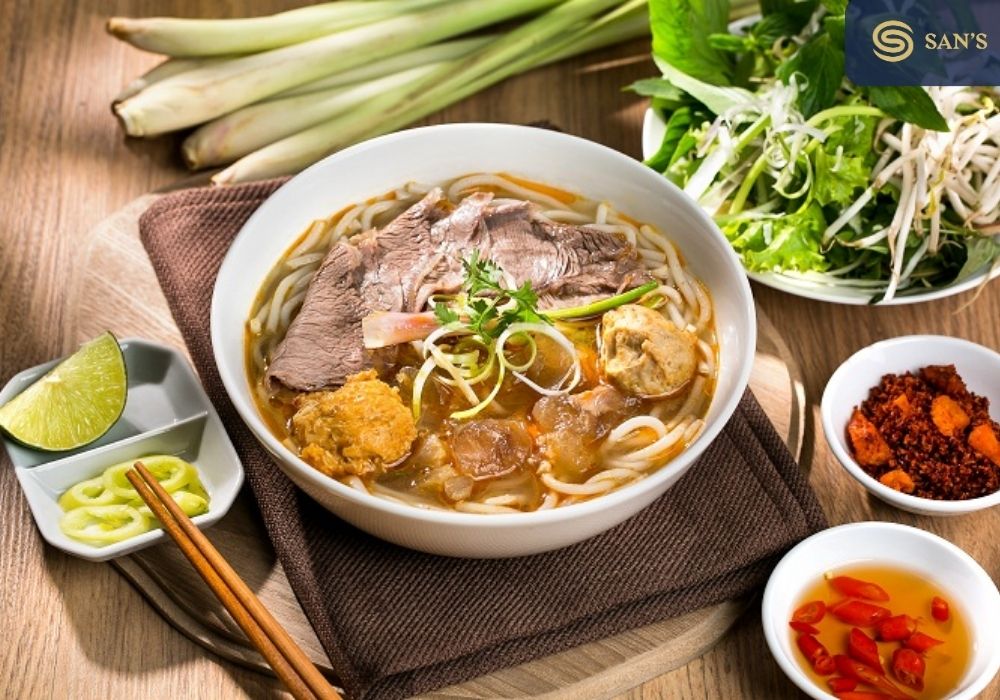Hanoi is a metropolis brimming with skilled chefs who take immense pride in their craft, as well as fervent food aficionados who cherish each bite. With that in mind, we’re excited to introduce you to 10 popular types of noodle Hanoi street food that will surely appease your appetite!
1/Pho (beef, chicken noodle soup)
If you’ve sampled any dish that embodies Vietnamese cuisine and Hanoi street food, it’s highly probable that it’s Pho bo. Crafted from fresh rice noodles and simmered in a slow-cooked beef broth overnight, this beef noodle soup stands out as a quintessential delight found on the streets of Hanoi.
-

Pho bo – Hanoi Street Food
While traditionally favored as a breakfast choice, this slurp-worthy noodle concoction has expanded its availability to all hours of the day in Hanoi. Whether you wander through the charming lanes of the Old Quarter or explore the elegance of the French Quarter, you’re bound to uncover an excellent pho bo eatery.
-

Pho ga – Hanoi Street Food
Another rendition of this culinary masterpiece is pho ga, characterized by its use of fresh rice noodles and shredded chicken immersed in chicken broth. Due to the distinctive nature of the broth, reputable pho establishments in Hanoi typically specialize in either chicken or beef pho, exclusively featuring one on their menus. The choice between the two is a personal one, and if you opt for chicken, here are three recommended destinations to relish a bowl of chicken noodle soup.
2/Bun cha (grilled pork with noodle dish)
Chunks of marinated pork patties and succulent pork belly slices are expertly charcoal-grilled to perfection before being delicately placed into a bowl of delectable cooked dipping sauce. This enticing dish is elevated by the addition of vibrant pickled carrot and kohlrabi, creating a harmonious blend of flavors and textures. Accompanied by rice vermicelli noodles and an ample plate featuring an assortment of lettuce, cilantro, and aromatic purple perilla, this culinary masterpiece promises an unforgettable experience.
-

Bun cha -Hanoi Street Food
Wherever the tantalizing aroma of grilled meats wafts through the streets of Hanoi, you can be sure that Bun cha is at the forefront of the city’s lunch choices. Here are three recommended establishments to savor this renowned dish.
3/Bun rieu cua (fresh water crab noodle soup)
Bun rieu cua is a delightful amalgamation of elements, bringing together white rice noodles, pounded freshwater crabs, crispy fried tofu, and tender slices of beef fillet. The crowning glory of this noodle soup is its distinctively vibrant crimson broth, a visual delight achieved through the infusion of tomato paste and annatto oil, extracted from the seeds of the achiote tree.
-

Bun rieu cua – Hanoi Street Food
In the list Hanoi street food, Bun rieu cua may be graced with an assortment of toppings, such as beef, snails, or fish. Served alongside a small basket brimming with an array of finely sliced green herbs, including lettuce, cilantro, and even banana blossoms, this dish presents a spectrum of flavors and textures. Enhanced by the zing of chili paste, the tang of tamarind, or the zest of kumquat, the crimson broth envelops the crab and greens, offering a harmonious interplay of spice and sourness.
4/Pho xao bo (stir fry noodles with beef)
Pho xao bo is a Hanoi street food that delectable creation featuring tender beef, velvety rice noodles, and an array of flavorful green vegetables. The preparation involves two distinct steps: the beef and vegetables are stir-fried individually before harmoniously combining them.
-

Pho xao bo – Hanoi Street Food
A final stir-fry, infused with aromatic garlic and savory soy sauce, ensures that every component is cooked to perfection, maintaining their ideal textures and flavors. To enhance the experience, a drizzle of rice vinegar or a squeeze of lime, along with a touch of chili and an additional hint of soy sauce, elevates the dish to its fullest potential.
5/Mien luon (eel cellophane noodle soup)
Mien Luon showcases a harmonious blend of two primary components: mien (cellophane noodles) and deep-fried or stir-fried luon (eel). Given the integral role of rice cultivation in Vietnamese culture, eels are cultivated within rice paddy fields, often synchronized with the two annual rice harvests.
-

Mien luon – Hanoi Street Food
Upon catching, the eels are treated by applying fresh lime juice to eliminate their natural slime and odor. Subsequently, the bones and heads of the eels are utilized to craft the broth, while the eel meat undergoes deep frying or stir frying. A steaming bowl of Mien luon is composed of fragrant broth, resilient vermicelli noodles crafted from arrowroot, delectable eel morsels, crunchy bean sprouts, crispy fried shallots, aromatic ginger, fresh cilantro, and Vietnamese coriander.
6/Bun doc mung (giant elephant ear stem noodle soup)
Bun doc mung stands out due to the inclusion of succulent stems from the giant elephant ear plant, also known as Indian taro. When prepared, these stems acquire a porous texture that impeccably absorbs the flavors infused into this noodle delicacy.
-

Bun doc mung – Hanoi Street Food
A serving of Bun doc mung offers gratification as each mouthful reveals the delectable amalgamation of savory meatballs, tender giant elephant ear stems, rice noodles, and thinly sliced pork hock. Crafted from a blend of ground pork and mushrooms, the meatballs are simmered within a tomato-rich broth, contributing to the dish’s flavorful profile.
7/Bun bo Nam Bo (Southern-style beef noodle dish)
Hailing from southern Vietnam, the dish aptly reflects its origin through its name. The foundation of the meal comprises rice noodles that intertwine with stir-fried beef, forming a satisfying base. Atop this canvas, an assortment of culinary elements is artfully arranged, including fried shallots, toasted peanuts, crisp lettuce, delicate microgreens, vibrant bean sprouts, julienne carrots, and refreshing cucumber.
-

Bun bo nam bo – Hanoi Street Food
The introduction of crispy fried shallots bestows a pleasing contrast in texture, while the fragrant essence of green papaya and pickled carrots infuses an alluring aroma. Upon amalgamation, the harmonious interplay and nutty undertones of these combined components propel the dish into a culinary spectacle that truly indulges both the senses and the palate.
8/Bun ca (fish noodle soup)
Bun ca is a Hanoi street food delectable dish encompassing the essence of deep-fried freshwater fish noodle soup. This culinary masterpiece marries meticulously fried fish segments with a rich fish-based broth, harmoniously accompanied by the invigorating presence of dill, tomatoes, spring onions, and perilla leaves. The crispy coat of the fried fish embodies an impeccably balanced texture—crunchy yet succulent, void of any undesirable fishiness or excessive dryness.
-

Bun ca – Hanoi Street Food
Upon immersion in the broth, the fried fish retains its crispness, seamlessly intertwining with the flavorful liquid. A symphony of flavors emerges as the dish is adorned with a subtle drizzle of lime, a dash of vinegar, the tantalizing heat of chili, and the aromatic embrace of assorted herbs. This orchestration results in the quintessential equilibrium of salty, sour, sweet, and spicy, culminating in a culinary experience that is both gratifying and gratifyingly balanced.
9/Bun bo Hue (beef noodle of Hue)
Bun bo Hue stands as the regal jewel of Hue, a historical city in central Vietnam with a former royal legacy. Even in Hanoi, the dish retains its nomenclature, Bun bo Hue, to honor its distinctive heritage. Within the confines of a single bowl of Bun bo Hue, a symphony of flavors unfolds, guided by a broth meticulously crafted through the slow simmering of beef bones, beef shank, oxtail chunks, pig’s knuckles, and pig’s blood—ultimately resulting in the formation of maroon, tofu-like cubes of coagulated richness.
-

Bun bo Hue – Hanoi Street Food
This extraordinary soup showcases an audacious interplay of robust flavors, employing an exquisite balance of spice and sourness to counterbalance the inherent elements of saltiness and sweetness. Below, we present two exceptional locales within Hanoi where one can indulge in the captivating experience of Bun bo Hue.
10/Bun thang (rice noodle with chicken, eggs and pork)
Bun thang stands as a quintessential representative of the northern Vietnamese noodle soup tradition—a culinary composition akin to an intricately crafted medicinal formula. This culinary masterpiece unfolds like a meticulously prepared package, housing a myriad of components reminiscent of a traditional prescription.
-

Bun thang – Hanoi Street Food
The artistry of Bun thang lies in its meticulous assembly, bringing together rice noodles as the base canvas upon which a symphony of toppings is skillfully arranged. Among these toppings are dried shrimps, wood ear mushrooms, tender shreds of chicken, delicate strips of pork sausage, thin ribbons of egg crepes, ethereal shrimp floss, sprightly spring onions, and an assortment of aromatic fresh herbs. A nourishing chicken broth is the elixir that unites these elements, infusing the dish with depth and harmony.
Just as traditional medicine prescriptions are often accompanied by supplementary components, Bun thang’s full flavor spectrum is elevated with the addition of lime, rice vinegar, shrimp paste, and chili sauce, all working in tandem to orchestrate an unforgettable taste experience.





